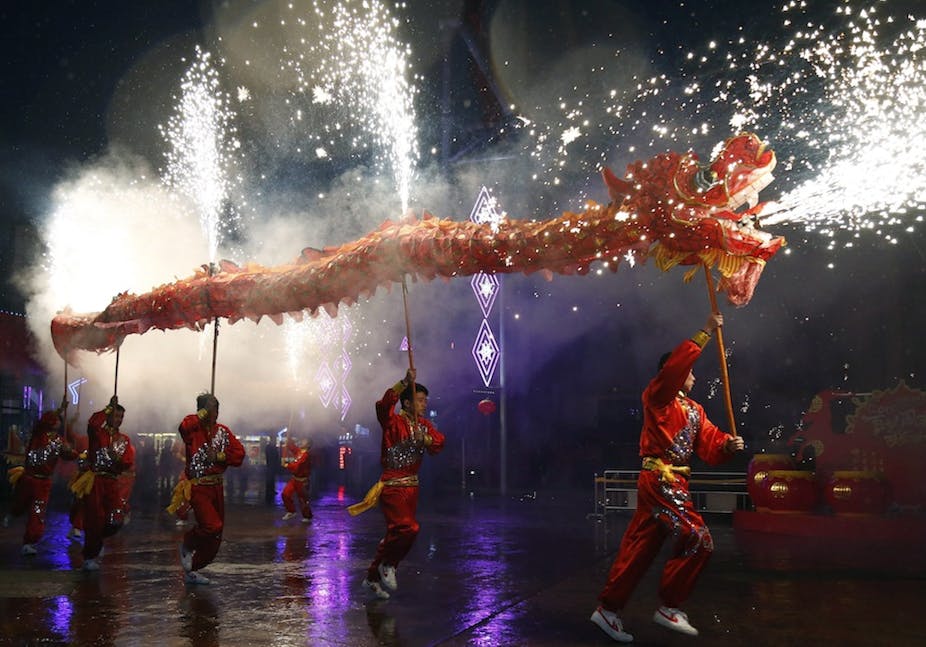China is in the middle of its annual economic hiccup. Forget the property sector that some fear is on the verge of imploding. And don’t worry about those scary shadow banks either. When it comes to China’s growth, nothing comes close to the effects of Chinese New Year.
You thought that traffic congestion on Australia’s motorways was bad when school’s out. China’s official news agency, Xinhua reports that its population will make 2.8 billion trips during this holiday season. From February 18-24, the country will officially be on leave.
When everyone has arrived, not much will be produced but lavish banquets will be eaten, copious volumes of rice wine drunk and red packets stuffed with cash exchanged.
Of course, seasonal fluctuations in economic activity are something that economists in Australia are familiar with. The folk at the Australian Bureau of Statistics have been adjusting our GDP numbers for the effects of Christmas for years.
But in China it takes on Great Wall proportions.
That Chinese New Year comes so soon after the country has just finished producing the goods that filled our department store shelves at Christmas only makes the fluctuations appear even wilder.
Take a look at what happens to output. Both Australia and China have a seasonal peak in the December quarter and a seasonal trough in the March quarter.
But in Australia, in any given year the value of output produced in the December quarter is usually only around 14% more than in the March quarter.
In China it’s 53%.
Put another way, if you look at consecutive fourth/first quarters, in Australia the value of output falls by around 6%. In China, it plunges by 25%.
This all takes some getting used to.
We never hear about the value of output falling. But it really does. It’s just that economists usually prefer to report and comment on data that has already had this seasonal effect stripped from it through some statistical wizardry. Sometimes though, it’s the seasonal effect that’s interesting.
Not only does the value of China’s output plunge in the March quarter, its composition changes radically too.
It’s become a cliché that economic growth in China leans heavily on investment and exports.
But there’s one quarter each year when any punter can predict that China’s economy will rebalance towards consumption and be sure to be right. In the March quarter last year, consumption accounted for 76.7% of the growth in GDP. That’s higher than in Australia.
Chinese New Year so badly distorts monthly retail sales data that in 2012 the hard-working boffins at China’s National Bureau of Statistics just gave up. Since then they’ve taken to only reporting a year-to-date value through the end of February and then starting again with the monthly releases in March.
Nowadays, the seasonality that comes with Chinese New Year also has an added twist. China’s economy has become so large that it gets exported.
But whereas Chinese New Year slows output growth in China, it gives it a boost in Australia.
Last year, the Year of the Horse arrived at the end of January. Sydney Airport reported that Chinese visitor traffic for the month was up an extraordinary 43% on the same period just one year earlier.
This year the firecrackers will be going off louder than ever.
Last month and just in time, Australia and China signed a new airline capacity deal. It immediately added 4000 seats from Beijing, Shanghai and Guangzhou to Australia’s gateway cities of Sydney, Melbourne, Brisbane and Perth. Another 7000 seats will follow by 2016.
Then there’s an extra 26,500 seats a week for Chinese airlines flying from second and third-tier Chinese cities. And by second-tier cities, we mean those around the size of Sydney.
Hikes in capacity will bring good fortune to Australia’s tourism industry because at peak times, like Chinese New Year, the numbers in the old agreement were already maxed out.
Chinese buying clout also leaped over the past year as the Renminbi appreciated nearly 10% against the Australian dollar.
Remember, these aren’t just any run-of-the-mill tourists.
Tourism Research Australia says that each Chinese visitor spends 27% more than those from the UK, 40% more than those from the US and 62% than those from Japan.
Welcome to the Year of the Goat (or is that a sheep?).

